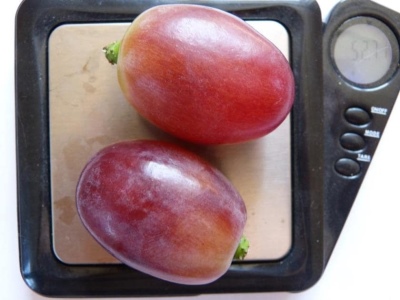
- Authors: Pysanka Oleg Mikhailovich
- Appointment: dining room
- Berry color: dark red
- Taste: simple, harmonious
- Ripening period: early middle
- Ripening period, days: 115-120
- Frost resistance, ° C: -23
- Bunch weight, g: 800
- Flower type: bisexual
- Density of the bunch: medium
Phaethon grapes can stay in the garden for a long time. But a good result can be achieved only after a competent study of this culture. And it should start with the origin of the variety.
Breeding history
The plant was bred by the breeder Oleg Pisanka. This is a typical dining culture. The original pair used to develop the hybrid has not been disclosed. The developer himself claims that this is an accidentally noticed successful seedling that appeared by itself. But connoisseurs have expressed their suspicions that the variety is a rip-off of the Modern grape; the similarity between them is very great.
Description
Ripening period
The variety belongs to the early-middle group. You can usually enjoy the fruits 115-120 days after disembarkation. As with other fruit plants, the weather can make its own adjustments. Full ripeness under normal conditions can be expected by mid-August. In bad weather conditions - 1-2 weeks later.
Bunches
The phaeton forms a nice looking cylindro-conical vine. Inside it, the berries are collected moderately densely. The total mass of the hand is 800 g, relatively dense. Some bunches reach a weight of 1.2 kg. They are distinguished by a decent presentation.
Berries
Dark red grapes look impressive and pleasant. Their peel is durable. The shape of the fruit is close to an oval. Its weight is 15-16 g. The grapes themselves are relatively large.
Taste
The peel can be eaten. It will hardly affect the feelings experienced. The taste is simple, but at the same time internally harmonious. They note the fleshiness and at the same time the juiciness of the flesh.
Yield
The Phaeton bush is distinguished by its great growth force. The vine can ripen almost the entire length of the shoot. Already the first harvest is accompanied by a heavy load on the bush. The fruits are not only numerous, but also have a full-fledged presentation.


Growing features
Landing
The plant is suitable for both open and closed culture. Sudden cold snaps and frosts are not particularly scary to him. Therefore, planting can be started both relatively early and relatively late. But even here it is necessary to observe a certain measure, because this resistance is only by the standards of grapes, and not other crops. A number of sources report that the freezing of the soil does not threaten Phaethon; but it is still better, of course, to choose a warm, poorly ventilated area facing south.
Experienced winegrowers note that this variety needs land where groundwater does not reach 2 m to the surface. The type of soil does not really matter. Planting can be done with a seedling or stock. It is necessary to ensure that Phaeton is not cramped.The support system is initially expected to grow strongly.

Pollination
The plant is bisexual. There is no need for pollination work. If conditions are too bad for natural pollination, you will not be able to achieve a normal harvest.
Pruning
The phaeton is distinguished by the strong growth of green parts. Therefore, you will have to take up the secateurs without fail. Overloading the bush and diseased shoots should be eliminated. In the first year, pruning the bush is not recommended. Always remove what has frozen over the winter.



Frost resistance and the need for shelter
The Phaeton variety retains its qualities at temperatures down to -23 degrees. This implies that shelter in most of Russia is essential. Even in relatively warm regions, winters are periodically too harsh for this grape.

Diseases and pests
Phaethon's resistance to such diseases dangerous for grapes is great as:
oidium;
mildew;
gray rot.
Other sources claim that disease resistance is low. Therefore, it is recommended to process plantings regularly as a preventive measure. It is believed that the greatest threat of all pests is wasps, and the fight against them should be uncompromising. Important: all treatments of the plants themselves are carried out before flowering. If it has already come, you have to wait for the end.

If a grape is exposed to any disease or insect, this always affects its appearance.
Storage
Since the skin is strong, the preservation should be higher than that of other grape varieties. There should also be no problems with transportation. It is stated that the preservation of fruits is possible for several months. It is still advisable not to risk it and use the refrigerator.











































































